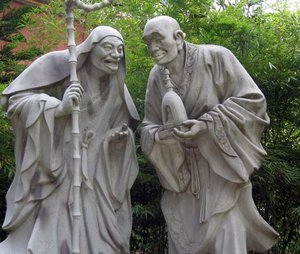Advertisement
Published: April 11th 2010

 Stone Arhats
Stone Arhats
These guys stand outside the Bamboo Temple and are fair game to photograph. The aesthetic of the clay Arhats inside is much the same--stylized and expressive.This last week, with Tom's parents visiting, we got a chance to get to some of the actual tourist sites around town, something we normally wouldn't make time for. They got out to some places like Lijiang and Dali, but I'm tied down with my school schedule, so I was only able to make it for some of the day trips.
Normally, I'm not the kind to get very excited about temples in China. Most of the Buddhist temples I've visited seem pretty much alike, and Taoist temples are just hard to come by. When in Beijing, we lived just a few blocks from the largest Taoist monastery in China, and one trip there was all I really needed, even though we ran past it nearly every day.
I'm glad I ventured out to
Bamboo Temple, though. It's built up into the side of one of the mountains surrounding the plateau that is Kunming. This particular Buddhist temple is especially famous for its 500 clay sculptures of Arhats--which my extremely limited and comically ignorant understanding of Buddhism tells me are guys who have achieved nirvana. Buddhism is complicated! So an Arhat is not necessarily a Buddha, but Buddha can be

 Inside the Temple
Inside the Temple
Here's a tranquil scene inside the temple. There are lots of wood and stone benches, red lanterns, and in Yunnan style, lots and lots of flowers.considered an Arhat. Boddhisattvas are a different ball of wax, and Mahayana Buddhism considers Boddhisattvas to be less selfish than Arhats. Oh, but the sculptures!
I only wish I could do the Arhats justice in words, because photographs of them are not permitted. These guys are arranged on narrow platforms lining the walls of several chambers in the temple. Each wall has three or four platforms on top of each other, so some of the Arhats are at eye level, and some of them are looming near the lofted ceiling. They stand shoulder-to-shoulder in different poses, each Arhat unique in every way. They're modeled in a stylized fashion after presumably real figures in Buddhist history. Some of them are happy, depicted with children alongside, and some are red-faced and angry, with bulging eyes. Other are accompanied by animal buddies, like elephants or tigers, and they definitely reflect a wide variety of ethnic looks, comprising Arhats from the furthest West reaches of Buddhist tradition to the East. But the creepy thing about these 500 guys, I have to say, is that they're modeled at something like 3/4 scale. They're like size of 13-year-olds.
Despite the unexpected romp through the

 Bamboo Wish
Bamboo Wish
Visitors carve a wishes or prayers into the bamboo around the temple. This one says 祝全家身体健康万事如意, meaning, "I wish my whole family the best of health, and the best of all things.", this temple in the mountains was actually incredibly calming, and probably the most tranquil place I've encountered in China. It's surrounded by bamboo forests, which you can reach through steps from the temple's courtyards, carved into the natural stone of the mountain. At the top of the steps there are canopied wooden walkways with traditionally carved eaves and painted illustrations of everything from scenes of legend to baskets of eggplants. These walkways segue into the beaten dirt paths of the woods, where people use pen knives to carve prayers along the length of the living bamboo.
There are also small (roughly the size of a pineapple) stone carvings of animals topping just about every suitable surface: the corners of planter boxes, the ends of handrails, even the bottoms of reflecting ponds. I collected photos of these and assembled many of them into a rendition of the Chinese zodiac, which you can see at the top of this entry. There were many other carvings of animals not in the pantheon, like fish, frog, and elephant, but the only zodiac animal I couldn't find was a dog! I substituted a fu-lion, or Chinese guardian lion, in the place of a

 Inexplicable Rhino
Inexplicable Rhino
Find enlightenment with this guy.dog in my little photo panorama, since artwork of these mythical lions is assumed to be modeled after Chow Chow dogs (the breed's name in Chinese is in fact "puffy lion dog").
In the realm of the animal sculptures, the stand-out is the rhinoceros. From the few people at the temple I asked, I didn't get a really clear reason for the high rhinoceros to any-other-animal ratio. In addition to several stone carvings, there are two life-sized metal casts of rhinos.
Advertisement
Tot: 0.09s; Tpl: 0.01s; cc: 8; qc: 46; dbt: 0.0516s; 1; m:domysql w:travelblog (10.17.0.13); sld: 1;
; mem: 1.1mb

 Stone Arhats
Stone Arhats
 Inside the Temple
Inside the Temple
 Bamboo Wish
Bamboo Wish
 Inexplicable Rhino
Inexplicable Rhino